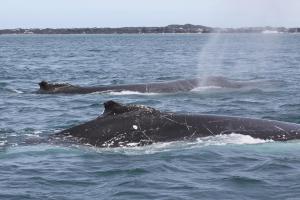First Whales Of The Season Arrive in Victoria - Call For Citizen Scientists To Watch For Injured Calf
The Two Bays Whale Project is calling Victorian citizen scientists to contribute whale sightings through ‘PodWatch’ App. www.dolphinresearch.org.au
MELBOURNE, VICTORIA, AUSTRALIA, June 6, 2019 /EINPresswire.com/ -- It was the first day of winter and the whale hotline started to buzz with sightings. Right on cue, humpback whales appeared in Port Phillip and along the coast of Phillip Island. Even more exciting was a sighting of a pod of killer whales at Port Phillip Heads on the same day!
Victorian whale watchers have been eagerly awaiting the arrival of these amazing marine mammals as they move from the wild Southern Ocean into warmer waters along Australia’s coastlines. For many years, Victoria mostly missed out on seeing these whales, however over the last decade, whale numbers have grown and we are now seeing the migration of humpback whales spilling into the coastal waters of Victoria’s Two Bays region (central Vic).
The Dolphin Research Institute is keenly interested in monitoring whale movements and with sightings becoming more regular, established the Two Bays Whale Project, a citizen science initiative specifically designed to capture information on visiting humpback, southern right and killer whales. This is a partnership with Wildlife Coast Cruises.
“The project has been an amazing step forward for the monitoring and management of large whales in our coastal waters.” said Project Coordinator David Donnelly. “In fact, just last season our citizen science community were instrumental in tracking a humpback whale entangled in cray pots.” This information was shared with wildlife managers to assist with the emergency response.
This year whale spotters are asked to keep watch for a young whale with a massive wound on its tail. Last year this little whale was photographed off Wilsons Promontory. Through the citizen science network it was matched to photos of a calf with a fresh gaping wound, taken 47 days earlier in Hervey Bay, Queensland. We suspect the calf had been attacked by sharks. In a remarkable feat, the mother whale was able to rescue her calf and travel over 2,000 kilometres to Victoria in 47 days. She would have also fed it about 100 litres of milk every day! We suspect they would have travelled to the sub Antarctic waters to feed over summer, so are very keen to see if it survived.
The Two Bays Whale Project is calling for citizen scientists to contribute sightings through ‘PodWatch’ its recently launched application. “It’s really quite simple, go to www.dolphinresearch.org.au and click on the sightings link”. For convenience, the system can be saved to your smart phone’s home screen and used like any other app, provided you have network coverage.
The community is asked to support the Institute’s GiveNow appeal: www.dolphinresearch.org.au
The Dolphin Research Institute respects the privacy of individuals and will not pass on personal details of people submitting sightings to a third party without permission. Details of sightings will be shared with the Victorian Biodiversity Atlas to contribute to the understanding and conservation of cetacea in our region.
MEDIA CONTACTS: for interviews or inquiries.
David Donnelly will be available for interviews
• David Donnelly (Two Bays founder and curator): 0401 011 022
• Jeff Weir (DRI Executive Director): 0419 356 388
• Email: director@dolphinresearch.org.au
RESOURCES: Images and vision of whales in the Two Bays region are available on request.
BACKGROUND:
STATUS OF WHALES
Hunted to the edge of extinction during the industrial whaling era, humpback whales have made an impressive comeback, with eastern Australian numbers expected to reach around 35,000 individuals this year. This is quite remarkable when you consider the post whaling population estimate to be only 200 – 400 individuals. Unfortunately, the news is not so good for the southern right whale, with their southeast Australian numbers estimated to be between just 250 and 300 individuals with little noticeable increase in population size.
The best land-based locations to see whales in the Two Bays region [June to September] are:
• Barwon Bluff
• Port Phillip Heads
• Cape Schanck
• The Nobbies,
• Pyramid Rock,
• Cape Woolamai on Phillip Island and
• the Bass Coast.
Report sightings to the Two Bays Whale Project at: www.dolphinresearch.org.au
Whale Watching Regulations: Substantial penalties apply to people deliberately approaching a whale closer than:
• 200m for vessels
• 300m for jetskis
• 500m height for aircraft (including drones)
Jeff Weir OAM
DOLPHIN RESEARCH INSTITUTE LTD
+61 419 356 388
email us here
Legal Disclaimer:
EIN Presswire provides this news content "as is" without warranty of any kind. We do not accept any responsibility or liability for the accuracy, content, images, videos, licenses, completeness, legality, or reliability of the information contained in this article. If you have any complaints or copyright issues related to this article, kindly contact the author above.

